| Eiectus Temporal range: Early Cretaceous, | |
|---|---|
 | |
| Specimen MCZ 1285, which may have been reconstructed with too many vertebrae | |
| Scientific classification | |
| Kingdom: | |
| Phylum: | |
| Class: | |
| Superorder: | |
| Order: | |
| Suborder: | |
| Family: | |
| Genus: | †Eiectus Noè & Gómez-Pérez, 2021 |
| Binomial name | |
| †Eiectus longmani Noè & Gómez-Pérez, 2021 | |
| Synonyms | |
Eiectus is a potentially valid genus of extinct short-necked pliosaur that lived in the Early Cretaceous period.[1][2] Fossil material has been recovered from the Wallumbilla Formation (Aptian) of Queensland was initially classified under the related genus Kronosaurus until 2021.[3]
History
Initial discoveries
A partial skull previously assigned to Kronosaurus queenslandicus that was discovered in 1929 in the same place as the holotype of K. queenslandicus probably belonged to Eiectus,[3] and another skull discovered in 1935 near Telemon Station in Hughenden, Queensland and prepared in May 1936 may have also belonged to Eiectus,[4] along with all other Albian remains previously referred to K. queenslandicus.[3]
MCZ 1285: the Harvard specimen
In 1931 the Harvard Museum of Comparative Zoology (MCZ) sent an expedition to Australia for the dual purpose of procuring specimens – the museum being "weak in Australian animals and...desires[ing] to complete its series" – and to engage in "the study of the animals of the region when alive."[5] The Harvard Australian Expedition (1931–1932), as it became known, was a six-man venture led by Harvard Professor William Morton Wheeler, with the others being Dr. P. Jackson Darlington Jr. (a renowned coleopterist),[6][7] Dr. Glover Morrill Allen and his student Ralph Nicholson Ellis,[8] medical officer Dr. Ira M. Dixon, and William E. Schevill (a graduate-student in his twenties and Associate Curator of Invertebrate Palaeontology).[9][5][10] MCZ director Thomas Barbour said at the time "We shall hope for specimens' of the kangaroo, the wombat, the Tasmanian devil and Tasmanian wolf," and the mission was a success with over 300 mammal and thousands of insect specimens returning to the United States.[6][9] Yet Mr. Schevill, the team's fossil enthusiast, remained in Australia after the others had departed and, in the winter of 1932, was told by the rancher R.W.H. Thomas of rocks with something "odd" poking out of them on his property near Hughenden.[4][11][9][12] The rocks were limestone nodules containing the most complete skeleton of Kronosaurus ever discovered.[4][13][14] After dynamiting the nodules out of the ground (and into smaller pieces weighing approximately four tons[15][16]) with the aid of a British migrant trained in the use of explosives,[17] William Schevill had the fossils shipped back to Harvard for examination and preparation. The skull—which matched the holotype jaw fragment of K. queenslandicus—was prepared right away, but time and budget constraints put off restoration of the nearly complete skeleton – most of the bones of which remained unexcavated within the limestone blocks – for 20 years.[13]
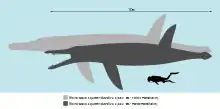
This interim ended when they came to the attention of Godfrey Lowell Cabot – Boston industrialist, philanthropist, and founder of the Cabot Corporation – "who was then in his nineties" and "had been interested in sea serpents since childhood."[9] Having formerly questioned MCZ director Alfred Romer about the existence and reports of sea serpents, it thus occurred to Dr. Romer to tell Mr. Cabot about the skeleton in the museum closet. Godfrey Cabot thus asked how much a restoration would cost and "Romer, pulling a figure out of the musty air, replied, 'Oh, about $10,000.'" Romer may not have been serious but the philanthropist clearly was because the check for said sum came shortly thereafter.[9][17] Two years – and more than $10,000 – later, following the careful labor of the museum preparators, the restored and mounted skeleton was displayed at Harvard in 1959.[4][13] However, Dr. Romer and MCZ preparator Arnold Lewis confirmed that same year in the institution's journal Breviora that "erosion had destroyed a fair fraction of this once complete and articulated skeleton...so that approximately a third of the specimen as exhibited is plaster restoration."[18] Furthermore, the original (real) bones are also layered in plaster; a fact that, while keeping the fossils safe, makes it difficult for paleontologists to study it – an issue which factors into the controversial question of the true size of the Kronosaurus queenslandicus.[17]
Welles (1962) suggested that MCZ 1285 should be the neotype of what would later become Eiectus.[19] Molnar (1982a, 1991) suggested that MCZ 1285 may not be conspecific with the holotype of Kronosaurus queenslandicus,[20][21] but instead believing that it represents a second species or a new genus that differs in having a deeper and more robust skull (followed by Thulborn and Turner, 1993).[22]
2021 revision of Kronosaurus

In 2021, a revision of K. boyacensis also transferred most of the remains of K. queenslandicus, including the Harvard remains, to a new genus and species, Eiectus longmani. The revision limits the genus Kronosaurus to the holotype mandible, and treats it as a nomen dubium.[3] Fischer et al. (2023) criticized the reassignments even under these circumstances, predicting that they stand contrary to ICZN Articles 75.5 and 75.6 (which codifies preference for neotype designation for previously iconic taxa with non-diagnostic holotypes) and that the aforementioned multiple-species possibility cannot justify a tentative reassignment of all specimens to Eiectus. The authors instead opted to refer to all relevant fossils as Kronosaurus-Eiectus.[23] A 2023 review of Australian fossil tetrapods restricted the name Eiectus to specimens MCZ 1285 and MCZ 1284.[24]
References
- ↑ Hampe O. (1992). Ein großwüchsiger Pliosauride (Reptilia: Plesiosauria) aus der Unterkreide (oberes Aptium) von Kolumbien. Courier Forschungsinstitut Senckenberg 145: 1–32.
- ↑ Kear BP. (2003). Cretaceous marine reptiles of Australia: a review of taxonomy and distribution. Cretaceous Research 24: 277–303.
- 1 2 3 4 Noè, L.F.; Gómez-Pérez, M. (2021). "Giant pliosaurids (Sauropterygia; Plesiosauria) from the Lower Cretaceous peri-Gondwanan seas of Colombia and Australia". Cretaceous Research. 132: 105122. doi:10.1016/j.cretres.2021.105122.
- 1 2 3 4 Mather, Patricia, with Agnew, N.H. et al. The History of the Queensland Museum, 1862–1986 Retrieved from archive.org
- 1 2 Gardiner, J. Stanley (September 1931). "The Harvard Museum Expedition to Australia". Nature. 128 (3228): 457–458. Bibcode:1931Natur.128..457G. doi:10.1038/128457c0. S2CID 29715877.
- 1 2 Capinera, John L. (2008). "Darlington, Jr., Philip J". Encyclopedia of Entomologists. pp. 1153–1154. ISBN 9781402062421.
- ↑ Hangay, George; Keyzer, Roger de. A Guide to Stag Beetles of Australia. Csiro Publishing. ISBN 978-1-4863-0209-3.
- ↑ Ralph Ellis archives, 1898–1972 – http://etext.ku.edu/view?docId=ksrlead/ksrl.sc.ellisralpharchives.xml Archived 2019-12-27 at the Wayback Machine
- 1 2 3 4 5 About the Exhibits by Elizabeth Hall and Max Hall (Museum of Comparative Zoology "Agazziz Museum" Harvard University. Third Edition, Copyright 1964, 1975, 1985, by the President and Fellows of Harvard College
- ↑ Annual report of the director of the Museum of Comparative Zoology at Harvard College, to the president of Harvard College for 1932–1933. Cambridge, U.S.A.: Printed for the Museum p.54-58 [BHL – https://www.biodiversitylibrary.org/page/41109461#page/58/mode/1up]
- ↑ "News-Press from Fort Myers, Florida". Newspapers.com. 1989-01-26. Retrieved 2023-09-05.
- ↑ "Trove". trove.nla.gov.au. Retrieved 2023-09-05.
- 1 2 3 Meyers, Troy. Kronosaurus Chronicles. Australian Age of Dinosaurs, Issue 3, 2005. Retrieved from australianageofdinosaurs.com
- ↑ "Zoology Museum to Exhibit Largest Sea-Reptile Fossil | News | The Harvard Crimson". www.thecrimson.com. Retrieved 2023-09-05.
- ↑ Rolfe, WD Ian. "William Edward Schevill: palaeontologist, librarian, cetacean biologist." Archives of Natural History 39.1 (2012): 162–164. – https://www.euppublishing.com/doi/pdfplus/10.3366/anh.2012.0069
- ↑ 1930s: The One That Got Away – https://australianmuseum.net.au/blogpost/museullaneous/1930s-the-one-that-got-away
- 1 2 3 The Rarest of the Rare: Stories Behind the Treasures at the Harvard Museum of Natural History (Hardcover) – 26 October 2004
- ↑ Romer, A. S. and A. D. Lewis. 1959. A mounted skeleton of the giant plesiosaur Kronosaurus. Breviora 112:1–15.
- ↑ Welles, S. P., (1962), A new Species of Elasmosaur from the Aptian of Colombia and a review of the Cretaceous Plesiosaurs. University of California Publications Bulletin Department of Geological Sciences 44: 1-89
- ↑ Molnar, R.E., (1982a). Australian Mesozoic reptiles. In: Rich, P.V., Thompson, E.M. (Eds.). Vertebrate palaeontology of Australasia. Monash University, Clayton, pp. 170–220.
- ↑ Molnar, R.E., (1991). Fossil reptiles in Australia. In: Vickers-Rich, P., Monaghan, J.M., Baird, R.F. et al., (Eds.). Vertebrate palaeontology of Australasia. Pioneer Design Studio, Monash University, Melbourne, pp. 605–702.
- ↑ Thulborn, T., Turner, S., (1993). An elasmosaur bitten by a pliosaur. Modern Geology 18, 489–501.
- ↑ Valentin Fischer; Roger B. J. Benson; Nikolay G. Zverkov; Maxim S. Arkhangelsky; Ilya M. Stenshin; Gleb N. Uspensky; Natalya E. Prilepskaya (2023). "Anatomy and relationships of the bizarre Early Cretaceous pliosaurid Luskhan itilensis". Zoological Journal of the Linnean Society. 198 (1): 220–256. doi:10.1093/zoolinnean/zlac108. S2CID 257573659.
- ↑ https://www.tandfonline.com/doi/full/10.1080/03115518.2023.2228367?scroll=top&needAccess=true&role=tab
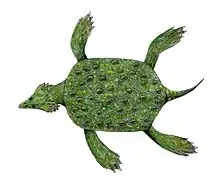
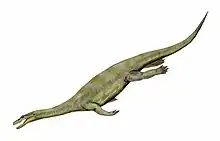
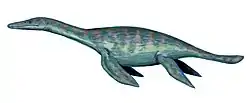

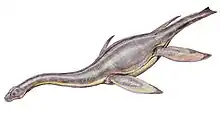
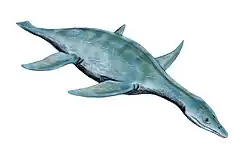
.png.webp)